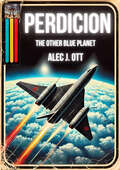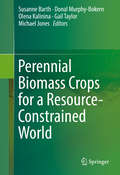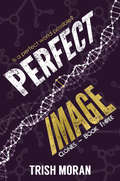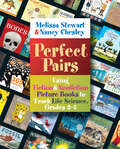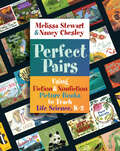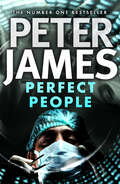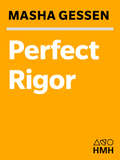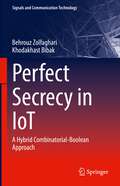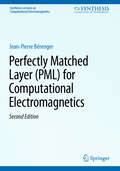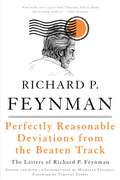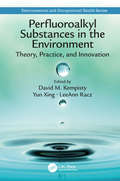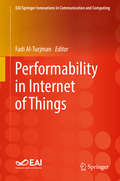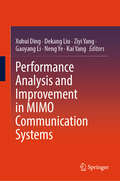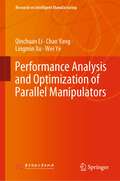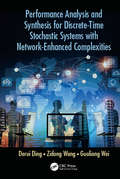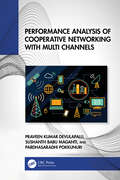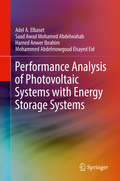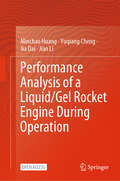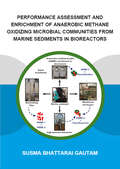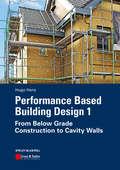- Table View
- List View
Perdicion: The Other Blue Planet
by Alec J. OttIn this space opera adventure, two planets battling for control of another confront a captain on a mission to protect the last known uncolonized planet. When the inhabitants of Perdicion discover there is life on the nearby planet of Parthenos, they rejoice in the possibilities. The most technologically advanced planet in the galaxy, Perdicion now dreams of space travel, exploration, and colonization. But first the forces of Perdicion have to overcome the rebellious Red Colonies, who also wish to make Parthenos their own. What the warring factions don&’t realize is that Parthenos has a protector in Commander Solus, who struggles between his desire to protect the pristine planet and his own need for advancing technology and weapons to use against the tyrants who would destroy the blue planet. The battle for Parthenos pits the past against the future and the old world against the new in pursuit of the soul of the last-known primitive planet.
Perennial Biomass Crops for a Resource-Constrained World
by Michael Jones Susanne Barth Donal Murphy-Bokern Olena Kalinina Gail TaylorThis book presents a flavour of activities focussed on the need for sustainably produced biomass to support European strategic objectives for the developing bioeconomy. The chapters cover five broad topic areas relating to the use of perennial biomass crops in Europe. These are: 'Bioenergy Resources from Perennial Crops in Europe', 'European Regional Examples for the Use of Perennial Crops for Bioenergy', 'Genotypic Selection of Perennial Biomass Crops for Crop Improvement', 'Ecophysiology of Perennial Biomass Crops' and 'Examples of End-Use of Perennial Biomass Crops'. Two major issues relating to the future use of biomass energy are the identification of the most suitable second generation biomass crops and the need to utilise land not under intensive agricultural production, broadly referred to as 'marginal land'. The two main categories of plants that fit these needs are perennial rhizomatous grasses and trees that can be coppiced. The overarching questions that are addressed in the book relate to the suitability of perennial crops for providing feedstocks for a European bioeconomy and the need to exploit environments for biomass crops which do not compete with food crops. Bioenergy is the subject of a wide range of national and European policy measures. New developments covered are, for example, the use of perennial grasses to produce protein for animal feed and concepts to use perennial biomass crops to mitigate carbon emissions through soil carbon sequestration. Several chapters also show how prudent selection of suitable genotypes and breeding are essential to develop high yielding and sustainable second generation biomass crops which are adapted to a wide range of unfavourable conditions like chilling and freezing, drought, flooding and salinity. The final chapters also emphasise the need to be kept an eye out for potential new end-uses of perennial biomass crops that will contribute further to the developing bioeconomy.
Perfect Image: The Clone Series (The Clone Series #3)
by Trish MoranThe final installment of Trish Moran's acclaimed young adult series exploring humanity, technology, and the problems of growing up in a dystopian future. Perfect for fans of The Giver and the Divergent trilogy.The Compound Labs, the original group of clones freed from the notorious medical centre, are continuing to live successfully alongside the normal humans in society.They are uneasy to realize that the militant group of clones, the Radicals, are gaining more and more followers from the Labs and their Hybrid children.The Radicals, sponsored by an anonymous billionaire, have a vision of a future society where every member is given a designated role according to their abilities. They have plans to rule this new way of life with a specially created perfect clone and his equally talented team, showing little regard for those they consider inferior mentally and physically.Have they created a team of unfeeling, super-intelligent people who will stop at nothing to achieve their aims?Are the Compound Labs strong enough to defeat them in their crusade? Can a young Hybrid girl use the power of love and compassion to challenge the course they have set themselves?
Perfect Image: The Clone Series (The\clone Ser. #3)
by Trish MoranThe final installment of Trish Moran's acclaimed young adult series exploring humanity, technology, and the problems of growing up in a dystopian future. Perfect for fans of The Giver and the Divergent trilogy.The Compound Labs, the original group of clones freed from the notorious medical centre, are continuing to live successfully alongside the normal humans in society.They are uneasy to realize that the militant group of clones, the Radicals, are gaining more and more followers from the Labs and their Hybrid children.The Radicals, sponsored by an anonymous billionaire, have a vision of a future society where every member is given a designated role according to their abilities. They have plans to rule this new way of life with a specially created perfect clone and his equally talented team, showing little regard for those they consider inferior mentally and physically.Have they created a team of unfeeling, super-intelligent people who will stop at nothing to achieve their aims?Are the Compound Labs strong enough to defeat them in their crusade? Can a young Hybrid girl use the power of love and compassion to challenge the course they have set themselves?
Perfect Pairs, 3-5: Using Fiction & Nonfiction Picture Books to Teach Life Science, Grades 3-5
by Melissa Stewart Nancy ChesleyHands-on lessons can be fun and compelling, but when it comes to life science, they aren't always possible, practical, effective, or safe. Children can't follow wolves as they hunt elk, visit a prehistoric swamp, or shrink down to the size of a molecule and observe photosynthesis firsthand. But they can explore a whole world of animals, plants, and ecosystems through the pages of beautifully illustrated, science-themed picture books. Perfect Pairs , which marries fiction and nonfiction picture books focused on life science, helps educators think about and teach life science in a whole new way. Each of the twenty lessons in this book is built around a pair of books that introduces a critical life science concept and guides students through an inquiry-based investigative process to explore that idea-;from life cycles and animal-environment interactions to the inheritance of traits and the critical role of energy in our world. Each lesson starts with a Wonder Statement and comprises three stages. Engaging Students features a hands-on activity that captures student interest, uncovers current thinking, and generates vocabulary. The heart of the investigative process, Exploring with Students, spotlights the paired books as the teacher reads aloud and helps students find and organize information into data tables. Encouraging Students to Draw Conclusions shows students how to review and analyze the information they have collected. Bringing high-quality science-themed picture books into the classroom engages a broad range of students, addresses the Performance Expectations outlined in the Next Generation Science Standards, and supports the goals of the Common Core State Standards for English Language Arts. Even if you are science shy, Perfect Pairs can help you become a more confident teacher whose classroom buzzes with curious students eager to explore their natural world.
Perfect Pairs, K-2: Using Fiction & Nonfiction Picture Books to Teach Life Science, K-2
by Melissa Stewart Nancy ChesleyHands-on lessons can be fun and compelling, but when it comes to life science, they aren't always possible, practical, effective, or safe. Children can't follow a lion as it stalks a gazelle, visit the exotic kapok tree in a rain forest, or swim alongside the underwater life in a pond. But they can explore a whole world of animals, plants, and ecosystems through the pages of beautifully illustrated, science-themed picture books. Perfect Pairs , which marries fiction and nonfiction picture books focused on life science, helps educators think about and teach life science in a whole new way. Each of the twenty-two lessons in this book is built around a pair of books that introduces a critical life science concept and guides students through an inquiry-based investigative process to explore that idea-;from animal/environment interactions to the role of structure in plant and animal survival, from inheritance of traits to variation of species. Each lesson starts with a Wonder Statement- and comprises three stages. Engaging Students- features a hands-on activity that captures student interest, uncovers current thinking, and generates vocabulary. The heart of the investigative process, Exploring with Students,- spotlights the paired books as the teacher reads aloud and helps students find and organize information into data tables. Encouraging Students to Draw Conclusions- shows students how to review and analyze the information they have collected. Bringing high-quality science-themed picture books into the classroom engages a broad range of students, addresses the Performance Expectations outlined in the Next Generation Science Standards, and supports the goals of the Common Core State Standards for English Language Arts. Even if you are science shy,Perfect Pairs can help you become a more confident teacher whose classroom buzzes with curious students eager to explore their natural world.
Perfect People
by Peter JamesIf it was the only way of having a child... would you do it? An unputdownable thriller from the global Number One bestseller author of the Roy Grace series.After the tragic loss of their young son to a rare genetic disorder, John and Naomi discover they both carry a rogue gene. Having another child by conventional means is too much risk to bear.When they find geneticist Dr Leo Dettore it seems like the answer to their prayers. Every aspect of the child can be chosen and manufactured, from height and eye colour to intelligence and sporting prowess. But realising the danger too late, Naomi is already pregnant when they understand the nightmare world they are entering…A world of perfect people.Utterly gripping and frighteningly plausible, Perfect People is a shocking thriller you won’t be able to put down about what happens when humans play God.Praise for Perfect People'Peter James's clever page-turner Perfect People focuses not on the past but risks for the future.' The Times'As ever, James writes beautifully, maintaining the pace with short, punchy chapters. But it's his firm grasp of the moral issues surrounding designer babies that makes Perfect People so satisfying – and so unsettling.' Guardian'James has produced a suitably breathless fan-pleaser about accelerating evolution.' Daily Telegraph'The ending is so horrifyingly scary that I was unable to sleep properly for several nights.' Mail on Sunday
Perfect Power: How the Microgrid Revolution Will Unleash Cleaner, Greener, and More Abundant Energy
by Robert Galvin Kurt YeagerWhat's the solution to the world's growing energy problem? ... PERFECT POWER ... Electric usage is rising. Fuel costs are rocketing. Blackouts are happening more frequently. Why? Because our electrical power system--built on a vast network of resources including nuclear energy, natural gas, water, and coal--has become woefully outdated, increasingly expensive, and dangerously fragile. We need to change the current system, and we need to do it now. ..Written by business visionary and former Motorola chairman Robert Galvin,Perfect Powershows us how to create a perfect system that can deliver power where needed, at an astonishing reliability standard of 99.9999999 percent. By super-charging the Six Sigma concepts that Galvin developed as the founder and CEO at Motorola, we can ... Meet the energy reliability and quality needs of the Digital Age. Generate new goods and services that create jobs, empower consumers, and lower energy cost. Eliminate wasteful spending on our electrical infrastructure that can be used for peak power needs. Facilitate local, regional, and, ultimately, national energy independence. Fundamentally reduce the impact of energy on the environment. Invest in the microgrid revolution. ... Energy providers and policy makers will reinvent today's centralized power systems and integrate them with new, efficient microgrids. Investors and entrepreneurs will spot tomorrow's hottest technologies. Consumers will demand change from the powers that be. And environmentalists will take advantage of cleaner, greener energy sources available. ... We have the power to fulfill our energy needs, fix our old systems, forge ahead with new ideas, and fuel our dreams. It's Perfect Power.
Perfect Rigor: A Genius and the Mathematical Breakthrough of the Century
by Masha GessenA gripping and tragic tale that sheds rare light on the unique burden of genius In 2006, an eccentric Russian mathematician named Grigori Perelman solved the Poincare Conjecture, an extremely complex topological problem that had eluded the best minds for over a century. A prize of one million dollars was offered to anyone who could unravel it, but Perelman declined the winnings, and in doing so inspired journalist Masha Gessen to tell his story. Drawing on interviews with Perelman's teachers, classmates, coaches, teammates, and colleagues in Russia and the United States--and informed by her own background as a math whiz raised in Russia--Gessen uncovered a mind of unrivaled computational power, one that enabled Perelman to pursue mathematical concepts to their logical (sometimes distant) end. But she also discovered that this very strength turned out to be Perelman's undoing and the reason for his withdrawal, first from the world of mathematics and then, increasingly, from the world in general.
Perfect Secrecy in IoT: A Hybrid Combinatorial-Boolean Approach (Signals and Communication Technology)
by Khodakhast Bibak Behrouz ZolfaghariPerfectly-secure cryptography is a branch of information-theoretic cryptography. A perfectly-secure cryptosystem guarantees that the malicious third party cannot guess anything regarding the plain text or the key, even in the case of full access to the cipher text. Despite this advantage, there are only a few real-world implementations of perfect secrecy due to some well-known limitations. Any simple, straightforward modeling can pave the way for further advancements in the implementation, especially in environments with time and resource constraints such as IoT. This book takes one step towards this goal via presenting a hybrid combinatorial-Boolean model for perfectly-secure cryptography in IoT. In this book, we first present an introduction to information-theoretic cryptography as well as perfect secrecy and its real-world implementations. Then we take a systematic approach to highlight information-theoretic cryptography as a convergence point for existing trends in research on cryptography in IoT. Then we investigate combinatorial and Boolean cryptography and show how they are seen almost everywhere in the ecosystem and the life cycle of information-theoretic IoT cryptography. We finally model perfect secrecy in IoT using Boolean functions, and map the Boolean functions to simple, well-studied combinatorial designs like Latin squares. This book is organized in two parts. The first part studie s information-theoretic cryptography and the promise it holds for cryptography in IoT. The second part separately discusses combinatorial and Boolean cryptography, and then presents the hybrid combinatorial-Boolean model for perfect secrecy in IoT.
Perfecting Engineering and Technical Drawing
by Ron HanifanThis concise reference helps readers avoid the most commonplace errors in generating or interpreting engineering drawings. Applicable across multiple disciplines, Hanifan's lucid treatment of such essential skills as understanding and conveying data in a drawing, exacting precision in dimension and tolerance notations, and selecting the most-appropriate drawing type for a particular engineering situation, "Perfecting Engineering and Technical Drawing" is an valuable resource for practicing engineers, engineering technologists, and students. Provides straightforward explanation of the requirements for all common engineering drawing types Maximizes reader understanding of engineering drawing requirements, differentiating the types of drawings and their particular characteristics Elucidates electrical reference designation requirements, geometric dimensioning, and tolerancing errors Explains the entire engineering documentation process from concept to delivery
Perfectly Matched Layer (Synthesis Lectures on Computational Electromagnetics)
by Jean-Pierre BérengerThis book presents the perfectly matched layer (PML) absorbing boundary condition (ABC) used to simulate the surrounding free space when solving the Maxwell equations with such finite methods as the finite difference time domain (FDTD) method or the finite element method. The frequency domain and the time domain equations are derived for the different forms of PML media, namely the split PML, the CPML, the NPML, and the uniaxial PML, in the cases of PMLs matched to isotropic, anisotropic, and dispersive media. The implementation of the PML ABC in the FDTD method is described with details. Propagation and reflection of waves in the discretized FDTD space are derived and discussed, with a special emphasize on the problem of evanescent waves. The optimization of the PML ABC is described for two typical applications of the FDTD method, firstly wave-structure interaction problems, secondly waveguide problems. A review of the literature on the application of the PML ABC to other numerical techniques of electromagnetics and to other partial differential equations of physics is provided. Finally, the design of PMLs suited to actual applications is revisited in the context of computers of the 2020’s that are, by far, more powerful than the computers of the 1990’s when the PML ABC was introduced. A simple and general-purpose method is described to design the PML in this current context.
Perfectly Reasonable Deviations From the Beaten Track: The Letters of Richard P. Feynman
by Richard P. FeynmanA Nobel Prize-winning physicist, a loving husband and father, an enthusiastic teacher, a surprisingly accomplished bongo player, and a genius of the highest caliber---Richard P. Feynman was all these and more. Perfectly Reasonable Deviations From the Beaten Track--collecting over forty years' worth of Feynman's letters--offers an unprecedented look at the writer and thinker whose scientific mind and lust for life made him a legend in his own time. Containing missives to and from such scientific luminaries as Victor Weisskopf, Stephen Wolfram, James Watson, and Edward Teller, as well as a remarkable selection of letters to and from fans, students, family, and people from around the world eager for Feynman's advice and counsel, Perfectly Reasonable Deviations From the Beaten Track not only illuminates the personal relationships that underwrote the key developments in modern science, but also forms the most intimate look at Feynman yet available. Feynman was a man many felt close to but few really knew, and this collection reveals the full wisdom and private passion of a personality that captivated everyone it touched. Perfectly Reasonable Deviations From the Beaten Track is an eloquent testimony to the virtue of approaching the world with an inquiring eye; it demonstrates the full extent of the Feynman legacy like never before. Edited and with additional commentary by his daughter Michelle, it's a must-read for Feynman fans everywhere, and for anyone seeking to better understand one of the towering figures--and defining personalities--of the twentieth century.
Perfluoroalkyl Substances in the Environment: Theory, Practice, and Innovation (Environmental and Occupational Health Series)
by David M. Kempisty Yun Xing LeeAnn RaczPer- and polyfluorinated alkyl substances (PFAS), often referred to as per- (and poly) fluorinated compounds (PFCs), have been used for years in many everyday¾ and some lifesaving¾ products. However, their use has been linked to adverse health effects in humans, a problem compounded by their persistence in the environment. This book discusses the various challenges of PFAS in our environment today, including their historical use as well as their chemical and toxicological properties. It also presents robust discussion of analytical challenges and special considerations in sampling. The work goes on to give practical recommendations for dealing with these compounds in today's dynamic regulatory landscape and includes several chapters on various remediation techniques. Key Features: Comprehensive overview of per- and polyfluorinated alkyl substances (PFAS) historical use and chemical/physical properties which help us understand their persistence, transport, and transformation pathways in the environment In-depth analysis of PFAS toxicology Detailed descriptions of conventional and state-of-the-art remediation technologies Practical recommendations for dealing with PFAS in a dynamic regulatory landscape Robust discussion of important sampling and analytical considerations Perfluoroalkyl Substances in the Environment: Theory, Practice, and Innovation explores the challenges across the topical areas of regulation and management, toxicology, environmental remediation, and analytical sampling and analysis.Readers will find this text helpful in understanding complexities associated with PFAS and informing management strategies to effectively protect this and future generations.
Performability in Internet of Things (EAI/Springer Innovations in Communication and Computing)
by Fadi Al-TurjmanThis book discusses the challenges in the convergence of technologies as the Internet of Things (IoT) evolves. These include sensing, computing, information processing, networking, and controlling intelligent technologies. The contributors first provide a survey of various assessment and evaluation approaches available for successful convergence. They then go on to cover several operational ideas to apply. The contributors then discuss the challenges involved bridging gaps in computation and the communication process, hidden networks, intelligent decision making, human-to-machine perception and large-scale IoT environments. The contributors aim to provide the reader an overview of trends in IoT in terms of performability and traffic modeling and efforts that can be spent in assessing the graceful degradation in IoT paradigms.Provides a survey of IoT assessment and evaluation approaches;Covers new and innovative operational ideas that apply to the IoT industry and the industries it affects;Includes chapters from researchers and industry leaders in IoT from around the world.
Performance Analysis and Improvement in MIMO Communication Systems
by Kai Yang Neng Ye Ziyi Yang Xuhui Ding Dekang Liu Gaoyang LiThis book focuses on the modeling and analysis of large-scale array communication systems to solve the computational complexity problems caused by high-dimensional arrays. This is achieved by providing an in-depth study on several major topics, such as channel estimation, delay estimation, angle estimation, and joint angle delay estimation. Both principles and engineering practice have been addressed, with more weight placed on engineering practice. The energy efficiency optimization problem of multi-antenna communication system is studied according to the actual situation of imperfect channel information and non-ideal hardware, and the corresponding high energy efficiency signal processing algorithm is proposed. The book benefits researchers, engineers, and graduate students in the fields of wireless communications and signal processing, etc.
Performance Analysis and Optimization of Multi-Traffic on Communication Networks
by Leonid Ponomarenko Agassi Melikov Che Soong KimPromptly growing demand for telecommunication services and information interchange has led to the fact that communication became one of the most dynamical branches of an infrastructure of a modern society. The book introduces to the bases of classical MDP theory; problems of a finding optimal САС in models are investigated and various problems of improvement of characteristics of traditional and multimedia wireless communication networks are considered together with both classical and new methods of theory MDP which allow defining optimal strategy of access in teletraffic systems. The book will be useful to specialists in the field of telecommunication systems and also to students and post-graduate students of corresponding specialties.
Performance Analysis and Optimization of Parallel Manipulators (Research on Intelligent Manufacturing)
by Qinchuan Li Chao Yang Wei Ye Lingmin XuThis book investigates the performance analysis and optimization design of parallel manipulators in detail. It discusses performance evaluation indices for workspace, kinematic, stiffness, and dynamic performance, single- and multi-objective optimization design methods, and ways to improve optimization design efficiency of parallel manipulators. This book collects the authors’ research results previously scattered in many journals and conference proceedings and presents them in a unified form after the methodical edition. As a result, numerous performance analyses and optimization of parallel manipulators are presented, in which the readers in the robotics community may be greatly interested. More importantly, readers can use the methods and tools introduced in this book to carry out performance evaluation and optimization of parallel manipulators by themselves. The book can provide important reference and guideline for undergraduate and graduate students, engineers, and researchers who are interested in design and application of parallel manipulators.
Performance Analysis and Synthesis for Discrete-Time Stochastic Systems with Network-Enhanced Complexities
by Zidong Wang Derui Ding Guoliang WeiThe book addresses the system performance with a focus on the network-enhanced complexities and developing the engineering-oriented design framework of controllers and filters with potential applications in system sciences, control engineering and signal processing areas. Therefore, it provides a unified treatment on the analysis and synthesis for discrete-time stochastic systems with guarantee of certain performances against network-enhanced complexities with applications in sensor networks and mobile robotics. Such a result will be of great importance in the development of novel control and filtering theories including industrial impact. <P><P>Key Features <li>Provides original methodologies and emerging concepts to deal with latest issues in the control and filtering with an emphasis on a variety of network-enhanced complexities <li>Gives results of stochastic control and filtering distributed control and filtering, and security control of complex networked systems <li>Captures the essence of performance analysis and synthesis for stochastic control and filtering <li>Concepts and performance indexes proposed reflect the requirements of engineering practice <li>Methodologies developed in this book include backward recursive Riccati difference equation approach and the discrete-time version of input-to-state stability in probability
Performance Analysis of Complex Networks and Systems
by Piet Van MieghemThis rigorous, self-contained book describes mathematical and, in particular, stochastic and graph theoretic methods to assess the performance of complex networks and systems. It comprises three parts: the first is a review of probability theory; Part II covers the classical theory of stochastic processes (Poisson, Markov and queueing theory), which are considered to be the basic building blocks for performance evaluation studies; Part III focuses on the rapidly expanding new field of network science. This part deals with the recently obtained insight that many very different large complex networks – such as the Internet, World Wide Web, metabolic and human brain networks, utility infrastructures, social networks – evolve and behave according to general common scaling laws. This understanding is useful when assessing the end-to-end quality of Internet services and when designing robust and secure networks. Containing problems and solved solutions, the book is ideal for graduate students taking courses in performance analysis.
Performance Analysis of Cooperative Networking with Multi Channels
by Praveen Kumar Devulapalli Sushanth Babu Maganti Pardhasaradhi PokkunuriThis book covers wireless cooperative communication and advanced communication techniques for research scholars and post-graduate students.Features:• This book will be the reference book for cooperative communication.• It addresses the problems in small-scale cooperative communication.• It presents cooperative routing algorithms for large-scale cooperative networks with the constraint of throughput and transmission time.• It presents energy- efficient transmission approach by making use of multiple radio terminals.• It presents adaptive routing algorithm for large-scale cooperative network under mobility environment.
Performance Analysis of Photovoltaic Systems with Energy Storage Systems
by Adel A. Elbaset Hamed Anwer Ibrahim Saad Awad Abdelwahab Mohammed Abdelmowgoud EidThis book discusses dynamic modeling, simulation, and control strategies for Photovoltaic (PV) stand-alone systems during variation of environmental conditions. Moreover, the effectiveness of the implemented Maximum Power Point Tracking (MPPT) techniques and the employed control strategy are evaluated during variations of solar irradiance and cell temperature. The simulation results are based on the reliability of the MPPT techniques applied in extracting the maximum power from the PV system during the rapid variation of the environmental conditions. The authors review two MPPT techniques implemented in PV systems, namely the perturb and observe (P&O) MPPT Technique and the Incremental Conductance (InCond) MPPT technique. These two MPPT techniques were simulated by the MATLAB/Simulink and the results response of the PV array from voltage, current, and power are compared to the effect of solar irradiation and temperature change.
Performance Analysis of a Liquid/Gel Rocket Engine During Operation
by Jian Li Jia Dai Minchao Huang Yuqiang ChengThis open access book takes space propulsion system, gel propulsion system, and pumped liquid rocket engine as research objects and establishes and describes the theory, dynamic model, and numerical calculation method of working process of liquid/gel rocket engine. The first part of this book establishes a mathematical model for the working process of the space propulsion system, including a mathematical model for gas cylinders, an electric explosion valve, a pressure reducing valve, a storage tank, a liquid pipeline, an orifice and filter, an electromagnetic valve, a filling pipeline, and a thrust chamber. The simulation analyzes the characteristics of the start-up, steady-state, and shutdown processes of the space propulsion system. In the second part, the mathematical model of the working process of gel propulsion system is established, and the flow distribution law, water hammer characteristics, and thrust regulation characteristics of gel propulsion system are simulated and analyzed. The third part establishes a mathematical model for the working process of a pumped liquid rocket engine and simulates and analyzes the starting process characteristics of the pumped liquid rocket engine. The above theory or dynamic model reflects the latest research results of the working process of liquid/gel rocket engine. This book is used as a teaching material or reference book for teachers, students, and scientific and technological personnel engaged in the simulation analysis of the working process of liquid/gel rocket engines in the fields of aerospace, aviation, power, etc.
Performance Assessment and Enrichment of Anaerobic Methane Oxidizing Microbial Communities from Marine Sediments in Bioreactors (IHE Delft PhD Thesis Series)
by Susma Bhattarai GautamAnaerobic oxidation of methane (AOM) coupled to sulfate reduction (AOM-SR) is a biological process mediated by anaerobic methanotrophs (ANME) and sulfate reducing bacteria. It has scientifi c and societal relevance in regulating the global carbon cycle and biotechnological application for treating sulfate-rich wastewater. This research aimed to enhance the recent knowledge on ANME distribution and its enrichment in different bioreactor confi gurations, i.e. membrane bioreactor (MBR), biotrickling fi lter (BTF) and high pressure bioreactor (HPB). Marine sediment from Ginsburg mud volcano, Gulf of Cadiz was used as inoculum in the BTF and MBR. The BTF operation showed the enrichment of ANME in the biofi lm, especially ANME-1 (40%) and ANME-2 (10%). Whereas, the dominancy of ANME-2 and Desulfosarcina aggregates was observed in the MBR. Moreover, HPB study was performed by using highly enriched ANME-2 community from Captain Arutyunov mud volcano. During the study of HPB at different temperature and pressure conditions, the incubation at 10 MPa pressure and 15˚C was observed to be the most suitable condition for the studied AOM-SR community. Furthermore, AOM-SR activity in the coastal sediments from marine Lake Grevelingen (the Netherlands) was explored and the microbial community was characterised which was dominated by ANME-3 among known ANME types.
Performance Based Building Design 1: From Below Grade Construction to Cavity Walls
by Hugo S. HensJust like building physics, performance based building design was hardly an issue before the energy crises of the 1970s. With the need to upgrade energy efficiency, the interest in overall building performance grew. The term "performance" encompasses all building-related physical properties and qualities that are predictable during the design stage and controllable during and after construction. The term "predictable" demands calculation tools and physical models that allow evaluating a design, whereas "controllable" presumes the existence of measuring methods available on site. The basis for a system of performance arrays are the functional demands, the needs for accessibility, safety, well-being, durability, energy efficiency and sustainability and the requirements imposed by the usage of a building. As the first of two volumes, this book applies the performance rationale, advanced in applied building physics, to the design and construction of buildings. After an overview of materials for thermal insulation, water proofing, air tightening and vapour tightening and a discussion on joints, building construction is analysed, starting with the excavations. Then foundations, below and on grade constructions, typical load bearing systems and floors pass the review to end with massive outer walls insulated at the inside and the outside and cavity walls. Most chapters build on a same scheme: overview, overall performance evaluation, design and construction. The book is absolutely recommended to undergraduates and graduates in architectural and building engineering, though also building engineers, who want to refresh their knowledge, may benefit. The level of discussion assumes the reader has a sound knowledge of building physics, along with a background in structural engineering, building materials and building construction. Where and when needed, input and literature from over the world was used, reason why each chapter ends listing references and literature.
